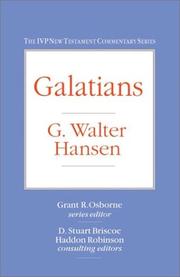| Listing 1 - 10 of 27 | << page >> |
Sort by
|
Book
Year: 1967 Publisher: Göttingen Vandenhoeck & Ruprecht
Abstract | Keywords | Export | Availability | Bookmark
 Loading...
Loading...Choose an application
- Reference Manager
- EndNote
- RefWorks (Direct export to RefWorks)
Book
ISBN: 1850751714 1474231225 9781850751717 Year: 1989 Volume: 29 Publisher: Sheffield: JSOT,
Abstract | Keywords | Export | Availability | Bookmark
 Loading...
Loading...Choose an application
- Reference Manager
- EndNote
- RefWorks (Direct export to RefWorks)
This book offers a fresh perspective on Paul's use of the Abraham story in Galatians by providing a thorough analysis of its epistolary and rhetorical contexts. In Part I, parallels in Galatians to rebuke-request letters in Greek papyri serve as a basis for dividing the letter into two major sections: Rebuke (1.6-4.11) and Request (3.12-6.10), the request formula in 4.12 indicating a major turning point in the letter. The Abraham argument (3.6-29) and the Hagar-Sarah allegory (4.12-31) should be viewed as Paul's biblical rebuke and biblical appeal respectively. Rhetorical analysis classifies 1
Book
Year: 1939 Publisher: Kbh. : De Unges Forlag,
Abstract | Keywords | Export | Availability | Bookmark
 Loading...
Loading...Choose an application
- Reference Manager
- EndNote
- RefWorks (Direct export to RefWorks)
Book
Year: 1909 Publisher: Nijkerk G.F. Callenbach
Abstract | Keywords | Export | Availability | Bookmark
 Loading...
Loading...Choose an application
- Reference Manager
- EndNote
- RefWorks (Direct export to RefWorks)
Book
Year: 1882 Publisher: Christiania Grøndahl
Abstract | Keywords | Export | Availability | Bookmark
 Loading...
Loading...Choose an application
- Reference Manager
- EndNote
- RefWorks (Direct export to RefWorks)
Worms --- Europe: North
Book
Year: 1885 Publisher: Christiania Grøndahl
Abstract | Keywords | Export | Availability | Bookmark
 Loading...
Loading...Choose an application
- Reference Manager
- EndNote
- RefWorks (Direct export to RefWorks)
Book
Abstract | Keywords | Export | Availability | Bookmark
 Loading...
Loading...Choose an application
- Reference Manager
- EndNote
- RefWorks (Direct export to RefWorks)
Book
Year: 1972 Publisher: Berlin Institut für Leistungsmedizin
Abstract | Keywords | Export | Availability | Bookmark
 Loading...
Loading...Choose an application
- Reference Manager
- EndNote
- RefWorks (Direct export to RefWorks)

ISBN: 083081809X Year: 1994 Publisher: Downers Grove InterVarsity press
Abstract | Keywords | Export | Availability | Bookmark
 Loading...
Loading...Choose an application
- Reference Manager
- EndNote
- RefWorks (Direct export to RefWorks)
Bible. --- Commentaries.
Book
ISBN: 9780802837370 0802837379 Year: 2009 Publisher: Grand Rapids, Mich. William B. Eerdmans
Abstract | Keywords | Export | Availability | Bookmark
 Loading...
Loading...Choose an application
- Reference Manager
- EndNote
- RefWorks (Direct export to RefWorks)
In this commentary G. Walter Hansen offers rich exposition of the text of Philippians as well as wisdom and maturity in its application. In so doing he emphasizes partnership -- the social and corporate dimensions of community -- in the progress of the gospel. After a select bibliography, Hansen's introduction sets forth the historical setting of the church in Philippi, the nature and occasion of the letter, and a preview of two key themes -- the gospel of Christ and the community in Christ. The commentary itself discusses Philippians in light of these themes, considering Paul's greetings, reports of gospel ministry, imperatives for citizens worthy of the gospel, recommendations of two Christ-like servants, and disclosures of his personal experience. Hansen's treatment as a whole is distinctive for the way it draws out and highlights the themes of partnership, citizenship, and friendship in Paul's Philippian letter. - Publisher.
| Listing 1 - 10 of 27 | << page >> |
Sort by
|

 Search
Search Feedback
Feedback About UniCat
About UniCat  Help
Help News
News